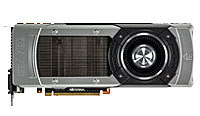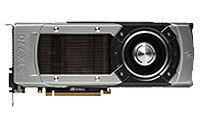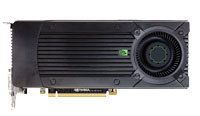Nvidia GTX 700 Series: Is It Worth It?
Nvidia's latest line of graphics cards are certainly more powerful than its previous offerings, but they haven't made last year's cards obsolete.
Nvidia’s GTX 700 graphics cards are enticing. The graphics giant hit a home run when it released the Kepler based 600-series cards in 2012, and with the retail inception of the GK110 GPU in the GTX 780 and GTX Titan cards this spring, their portfolio of high-end hardware continues to look better than ever.
Of course, not everyone can afford a single piece of hardware that costs $650 or $1,000. Fret not: The GTX 780 and GTX Titan are champions in their category, but there’s no reason to believe their relative power makes other 700-series cards bad investments. For that matter, the 600-series shouldn’t be discounted either.
 GeForce GTX 780, $650
GeForce GTX 780, $650
The best-in-class 700-series card packs the same GK110-laced punch as the $1,000 Titan with a few tweaks: less RAM and fewer CUDA cores, but slightly faster clock rates on the GPU.
 GeForce GTX 770, $399
GeForce GTX 770, $399
You won’t find the GK110 here; inside the GTX 770 is the same GK104 from the 600-series. This card surpasses the GTX 680 with faster clock rates, RAM, and increased memory bandwidth, but at the cost of increased power consumption.
 GeForce GTX 760, $249
GeForce GTX 760, $249
Nvidia’s barebones 700-series card is less than half the price of the top-of-the-line GTX 780, and it shows, but it’s hard to beat in terms of raw value, giving the GTX 670 a serious run for its money.
| GeForce Card | GPU | CUDA Cores | Base/Boost clock | Mem. Config. | Mem. Clock | Mem. Bus | Mem. Bandwidth | TDP Power |
|---|---|---|---|---|---|---|---|---|
| GTX 660 (OEM) | GK104 | 1152 | 823/888 MHz | 2 GB GDDR5 | 6.0 Gbps | 192-bit | 134 GB/sec | 140 W |
| GTX 670 | GK104 | 1344 | 915/980 MHz | 2 GB GDDR5 | 6.0 Gbps | 256-bit | 192.2 GB/sec | 170 W |
| GTX 680 | GK104 | 1536 | 1006/1058 MHz | 2 GB GDDR5 | 6.0 Gbps | 256-bit | 192.2 GB/sec | 195 W |
| GTX 760 | GK104 | 1152 | 980/1033 MHz | 2 GB GDDR5 | 6.0 Gbps | 256-bit | 192.2 GB/sec | 170 W |
| GTX 770 | GK104 | 1536 | 1046/1085 MHz | 2 GB GDDR5 | 7.0 Gbps | 256-bit | 224.3 GB/sec | 230 W |
| GTX 780 | GK110 | 2304 | 863/900 MHz | 3 GB GDDR5 | 6.0 Gbps | 384-bit | 288.4 GB/sec | 250 W |
| GTX Titan | GK110 | 2688 | 837/876 MHz | 6 GB GDDR5 | 6.0 Gbps | 384-bit | 288.4 GB/sec | 250 W |
With a GTX 780, GTX 770, and GTX 760 in hand, we’ve run the tests. There were some surprises, but as expected, the mid-range offers the best bang for your buck. Still, the budget-conscious GTX 760 is a worthy contender at the $250 price point.



The difference in price between the GTX 760 and GTX 770, compared to the GTX 770 and GTX 780, is nearly uniform. However, the performance gap is smaller for the latter option. Therefore, where value is concerned, the GTX 770 is the best compromise of cost and performance. For $250, the GTX 760 remains a good deal for a capable graphics card, but one that may only remain relevant in the short term.
So, where does that leave the 600-series? With so many variations from third party manufacturers in the wild, it's difficult to narrow down averages of price and features across the board for each 600-series card. To form a general idea of your options, we compared the prices for "vanilla" versions of the GTX 680, GTX 770, and GTX 660 from EVGA.
Starting at the top, EVGA's GTX 680 currently costs $489. It's roughly comparable to the $400 GTX 770, which features greater memory bandwidth and faster clock rates. Knowing this, anyone considering a GTX 680 should move on to the GTX 770. The only downside to the GTX 770 over the GTX 680 is its larger power requirements.
The $320 EVGA GTX 670 shares some specs with the GTX 760, but it packs more CUDA cores, albeit with slower overall clock rates. Is the difference in the CUDA shader cores worth the extra $70 that the GTX 670 costs? Not really. The GTX 760 is really for people without flexible budgets. If you're considering spending an extra $70 for a minor upgrade in performance, you may as well drop $80 more for an even bigger boost with the GTX 770, a card which bests the GTX 680 in performance and price.
And then there's the GTX 660. Outside of memory bandwidth, which takes a notable hit on the GTX 660, the GTX 660 and the GTX 760 aren't that dissimilar. EVGA currently sells the plain GTX 660 for $200, with the GTX 770 going for $250. The 20% difference in cost, compared to the relatively larger gap in memory bandwidth (30%) makes the GTX 760 the obvious better value.
The high-end GTX 780 brings the best of the GTX Titan to the 700-series, but it's price tag--like the Titan--puts it in a class of its own. Still, it's a good option for anyone who can afford a $650 graphics card. For everyone else, the rest of the current GTX 700 lineup are great options compared to comparable cards in the 600-series, and though Nvidia hasn't upped the bar for performance as much as it did with the introduction of the 600-series, the GTX 700 cards are a better value overall.
Got a news tip or want to contact us directly? Email news@gamespot.com
Join the conversation